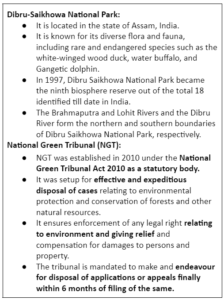Context: Recently, National Green Tribunal (NGT) ordered the Assam government to disburse interim compensation to the victims of Baghjan oil and gas leak that displaced close to 9,000 people in 2020 in Tinsukia district of Assam.
 More on News:
More on News:
 More on News:
More on News:
- About: Baghjan 5 well is a purely gas-producing well in Tinsukia district, and is at an aerial distance of 900 metres from the Dibru-Saikhowa National Park.
- It was drilled by Oil India Limited (OIL) in 2006.
- It produces around 80,000 standard cubic metres per day (SCMD) of gas from a depth of 3,870 metres.
- Baghjan oil and gas leak is considered as the longest running oil spill in the country.
- National Green Tribunal (NGT) appointed a committee led by Justice (retired) BP Katakey to investigate the leak, which revealed many violations of environmental laws deeming the entire Baghjan oil and gas field as illegal in November 2020.
- The committee submitted that one-time compensation should be given to the affected villagers from Baghjan based on the quantum of losses faced by the affected villages.
- About: An oil spill is the release of a liquid petroleum hydrocarbon into the environment, especially the marine ecosystem, due to human activity, and is a form of pollution.
- Oil spills can have disastrous consequences for society, economically, environmentally, and socially.
- Oil spills can harm aquatic life, contaminate drinking water, damage shorelines and beaches, affect tourism and commerce, and pose fire hazards.
- Indian Coast Guard is the Central Coordinating Authority in India for matters related to Oil Spill.
- National Oil Spill Disaster Contingency Plan (NOSDCP) promulgated by Indian Coast Guard (ICG) is the apex plan for responding to oil spill disasters in Indian waters and is applicable to shipping, ports, and oil industries.
- It outlines the roles and responsibilities of various agencies and stakeholders in preventing and combating oil spills in different maritime zones, except in the waters of ports and within 500m of offshore platforms, refineries and associated facilities.
- It encompasses preparedness and response for hazardous and noxious substances (HNS) incidents.
Post Views: 237
